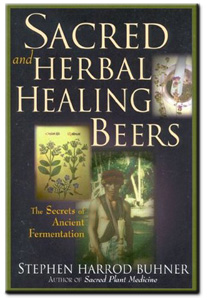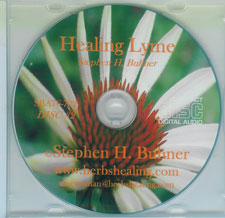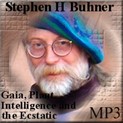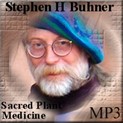Paradise Lost: Of Healing, the Sacred, and Beer (part two )
by Stephen Harrod Buhner
Written 1998, Copyright © 2003 Stephen Harrod Buhner
Excerpt from Sacred and Herbal Healing Beers:
The Secrets of Ancient Fermentation
(Read part one)
The inebriating herbs of the longest historical use in European brewing are heather mead and those that went to make up gruit.  Gruit ale held sway over Europe for nearly a thousand years and heather mead and ale (the original Mead of Inspiration) has been made in the area known today as Scotland for at least four thousand years. But the use of such powerful herbs is undoubtedly much more ancient and has been an integral part ofthe magic of fermentation and herbal lore for millennia.
Gruit ale held sway over Europe for nearly a thousand years and heather mead and ale (the original Mead of Inspiration) has been made in the area known today as Scotland for at least four thousand years. But the use of such powerful herbs is undoubtedly much more ancient and has been an integral part ofthe magic of fermentation and herbal lore for millennia.
Gruit was, primarily, a combination of three herbs: Sweet Gale (Myrica gale), Yarrow (Achillea millefolium), and Wild Rosemary (Ledum palustre). Gruit and these three herbs all had the reputation of being highly inebriating, sexually stimulating, and mildly psychotropic. The Norwegian brewing historian, Odd Nordland notes about sweet gale that "It was said locally that when one drank much of it, it was strongly intoxicating, with unpleasant after effects." And Maude Grieve observes in A Modern Herbal that "The leaves [of wild rosemary] are reputed to be more powerful than those of Ledum latifolium [Labrador Tea], and to have in addition some narcotic properties."
Nordland comments on that most innocuous of herbs, yarrow: "According to Linneaus, itwas used by the people of Lima in Dalecarnia, instead of hops, when they brewed for weddings: '. . . so that the guests become crazy.' Linneaus called the plant galentara, [meaning] 'causing madness.' " Modern research shows that, indeed, all three plants contain substances that alter consciousness and can cause extreme inebriation when consumed in quantity.
To understand the radical change that is involved in the shift from gruit to the hopped beer we now drink, it is important keep in mind the properties of gruit ale: it is highly intoxicating - narcotic, aphrodisiacal, and psychotropic when consumed in sufficient quantity. The hopped ale that took its place is quite different. Its effects are sedating and anaphrodesiacal. In other words it puts the drinker to sleep and dulls sexual desire. Hops is extremely high in estrogenic and soporific compounds. The phytoestrogens make it great for women in menopause but never good for men. (In fact there is a well-known condition among inn keepers and brewers in England called "brewer's droop.")
When Hops began to be suggested for use as a primary additive in ale, the opposition was tremendous. Those who held a monopoly on gruit production in Germany (the Catholic Church) and on pure ale in England fought hop introduction through the legislatures, proclamations of the royalty, writings of the day's medical practitioners, and through church edict.  Hops, until this time, was merely one of the plants used all along in the production of beer - the earliest mention of its use probably being in Hildegard of Bingen's (1098-1179) Physica, though she insisted that other than its preservative qualities "It is not much use for a human being, since it causes his melancholy to increase, gives him a sad mind, and makes his intestines heavy."
Hops, until this time, was merely one of the plants used all along in the production of beer - the earliest mention of its use probably being in Hildegard of Bingen's (1098-1179) Physica, though she insisted that other than its preservative qualities "It is not much use for a human being, since it causes his melancholy to increase, gives him a sad mind, and makes his intestines heavy."
The struggle over what ingredients could be allowed in ale lasted, in its most furious forms, for about two hundred years. Eventually Protestant reformists succeeded in breaking the Catholic monopoly on gruit and, in an attack on the inebriating herbs used in fermentations, made hops the standard microbial herb used to flavor and preserve beer. The result was the end of a many thousand year tradition of herbal beer making in Europe and the narrowing of beer and ale into one limited expression of beer production, that of hopped ales or what we today call beer. Gruit disappeared from European commercial brewing by 1750. It held on longest among Icelandic and Norwegian village brewers until after world War 2 when Protestant Temperance movements put an end to it.
But gruit was only the most common of European ales that were inebriating. Perhaps the most powerful was henbane. The henbane plant, Hyoscyamus niger, is known under a variety of names in Europe: bilsa, bilsenkraut, pilsenkrut, and pilsen. In fact the original pilsner beer meant a henbane ale. Researcher Christian Rasch comments that "In low doses, beer brewed with henbane has an inebriating effect; in moderate doses, it is an aphrodisiac. . . . In high doses, it leads to delirious, "demented" states, confusion, disturbances of memory, and mad behaviors having no apparent cause." It is, in fact, a plant that needs to be used with extreme caution.
But it is all too easy, in the fascination and fear that Americans often have with psychotropics, to lose sight of the understanding of ancient and indigenous peoples that all plants change consciousness. They just do it in different ways; some are much more subtle.
Perhaps one of the most powerful and sacred of plants in Europe was mugwort (Artemisia vulgaris). Mugwort, one of the commonest plants used for brewing in the middle-ages (the literal meaning is "beer-plant") was also considered one of the nine sacred herbs of the ancient Europeans. An ancient pre-Christian lay about mugwort, contained in the Lacnunga, a Wessex herbal from the 10th century, comments on its powerful attributes.
Have in mind, Mugwort, what you made known,
What you laid down, at the great denouncing.
Una your name is, oldest of herbs
Of might against thirty, and against three,
Of might against venom and the onflying,
Of might against the demons who fare through the land.
Like all members of this family mugwort has been traditionally used throughout the world in sacred ceremonies, by indigenous peoples as smudge and in sweat lodges, and for prayer offerings. But mugwort also possesses powerful healing properties. Traditional folk herbalists in over fifty countries have historically used mugwort for regularizing menstruation (used both to stimulate scanty menstruation or slow excessive bleeding), to calm hysteria and for nervous disorders, as a tonic, to expel worms, as an antibacterial poultice for wounds, and for fevers.
Like many of the ales in Europe in the middle ages, mugwort
ale was used as much for its healing as its sacred properties or even its good taste. One of the seminal discoveries of European brewing was that fermentation was a powerful way to preserve medicines. An herbal infusion was made, sugar added, then it was fermented. The resulting ale was stored in kegs and consumed for specific conditions whenever needed. The alcohol helped preserve the infusion and ensured patient compliance - it is a lot more fun to drink your medicine after all. Historical ales for menstrual problems, scurvy, kidney stones, insomnia, and gout were all commonly available and scores more. The great English herbalist Maude Grieve sums it up when she says:
Formerly every farmhouse inn had a brewing plant, and
brewhouse attached to the buildings, and all brewed
their own beer till the large breweries were
established and supplanted home-brewed beers. Many of
these farmhouses then began to brew their own 'stingo'
from wayside herbs, employing old rustic recipes that
had been carried down from generation to generation.
The true value of vegetable bitters and herb beers have
yet to be recognized by all sections of the community.
In many ways the true value and wondrous mystery of herbal
fermentations, of brewing itself, has yet to be recognized in our
modern Western world. But the mystery is still there, waiting to
awaken our wonder, if we only let go and drink a little deeper.
by Stephen Harrod Buhner
author of Sacred and Herbal Healing Beers
(read part one)
Sacred and Herbal Healing Beers:
The Secrets of Ancient Fermentation

Paperback by Stephen Harrod Buhner. 450 pp. Herbal healing beers of the world.
This is the first comprehensive book ever written on the sacred aspects of indigenous, historical psychotropic and herbal healing beers of the world.
"Filled with nourishment for the soul, body, and mind, this book is a unique view of the intersection between herbal medicine and fermentation. It will delight anyone interested in herbs, honey, brewing and folktales. Great Book!" -- Susun S. Weed, Author of Healing Wise.
Price: $19.95
Order Sacred and Herbal Healing Beers in our Bookshop
Healing Lyme: Natural Healing and Prevention of Lyme Borreliosis and Its Coinfections
 Paperback by Stephen Harrod Buhner. 288 pp. The essential guide to Lyme infection and its treatment.
Paperback by Stephen Harrod Buhner. 288 pp. The essential guide to Lyme infection and its treatment.
Healing Lyme examines the leading, scientific research on Lyme infection, its tests and treatments, and outlines the most potent herbal medicines and supplements that offer help—either alone or in combination with antibiotics—for preventing and healing the disease.
It is the essential guide to Lyme infection and its treatment.
A must have book for anyone dealing with Lymes...
Price: $19.95
Order Healing Lyme in our Bookshop
also on CD....
Healing Lyme - 2 CD set
Stephen H Buhner. 8th International Herb Symposium 2007.
 In this workshop Stephen presents the research and treatment interventions from his book "Healing Lyme: Natural Healing and Prevention of Lyme Borreliosis and its Coinfections."
In this workshop Stephen presents the research and treatment interventions from his book "Healing Lyme: Natural Healing and Prevention of Lyme Borreliosis and its Coinfections."
The ecology of the Lyme bacterium, how and why it affects the organ systems it does, and multiple, coordinated intervention approaches will be discussed. Updates from the more than 400 people who have used the protocol will be presented.
Price: $22.50
Order Healing Lyme - 2 CD set in our Bookshop
digital downloads by
Stephen H. Buhner

Gaia, Plant Intelligence and the Ecstatic
- digital download
Stephen H. Buhner. 8th International Herb Symposium 2007.
Teacher: Stephen Harrod Buhner
Price:$19.95

The End of Antibiotics - digital download
Stephen H. Buhner. 5th International Herb Symposium 2000.
Teacher: Stephen Harrod Buhner
Price:$19.95

Sacred Plant Medicine - digital download
Stephen H. Buhner. HerbFest 1999.
Teacher: Stephen Harrod Buhner
Price:$19.95


 Paperback by Stephen Harrod Buhner. 288 pp. The essential guide to Lyme infection and its treatment.
Paperback by Stephen Harrod Buhner. 288 pp. The essential guide to Lyme infection and its treatment.





